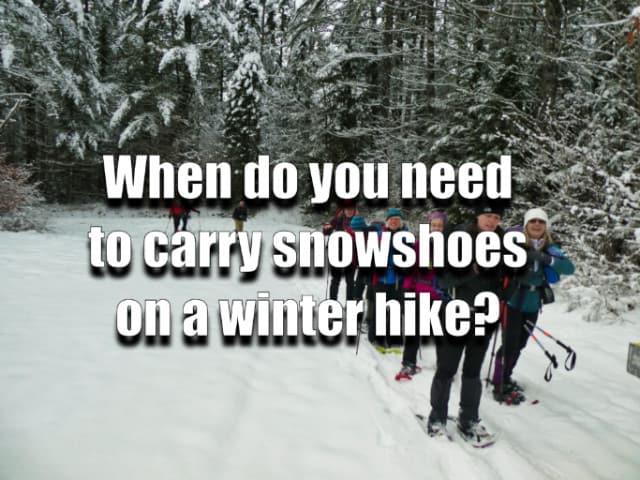
Snowshoes are heavy, weighing between four and five pounds a pair, so most winter hikers are happy when they don't have to carry them on a winter hike. But how can you tell when they won't be needed? This is a question that vexes many winter hikers. When you add up all the gear, clothing, hot water, and food needed for winter hiking, shedding those five pounds of snowshoes is very attractive. Hiking without them strapped to your back or feet takes less energy and is a lot more comfortable.
Flotation
The primary purpose of snowshoes is to provide flotation so you don't sink into snow while hiking. Hikers without snowshoes can plunge knee or waist deep into unconsolidated snow if they try to cross it without snowshoes. This can be quite exhausting and makes you sweat profusely, which can chill you in winter and lead to hypothermia. However, the enlarged surface area of a snowshoe deck helps distribute your weight across the surface of the snow so you don't sink into it, you expend less energy, and sweat less.
Broken Out Trails
But how do you know if you'll need them or not? You need to figure out whether other hikers have already "broken out" the trail you want to hike or whether recent snowfall has covered up their tracks. When hiker's snowshoe over a trail covered with fresh snow, they compress the snow underfoot, packing it down. As more and more hikers snowshoe or hike over it, it will become firmer and firmer, and possibly even icy. It will stay this way until more snow falls on top of it or it melts out.
Barebooting
If you can find a broken out trail, you can probably bare boot it. Barebooting means that you're hiking without snowshoes or microspikes, relying just on your boot sole lugs for traction. If it's snowed since the last time a broken out trail was hiked, you can still probably hike it without snowshoes, as long as the depth of the new snow is a few inches deep and below your ankles. Much higher and you'll probably find it easier to hike with snowshoes for flotation.
Message Boards and Facebook Groups
If you want to avoid carrying snowshoes on hikes, it's best to pick trails that have already been broken out and packed down by other winter hikers. If you winter hike someplace that has a well developed trail system and hiker population, try to find a message board or Facebook Group where hikers post trip reports or share trail condition information with one another. For example, I usually check a bulletin board called NETRAILCONDITIONS when I winter hike in New Hampshire or Southern Maine, which shows me which trails have been hiked recently and whether snowshoes or microspikes are recommended. Try to find something similar in the area where you hike.
Snow Depth Information
If you want to hike on a trail and can't find any recent trail condition information for it, try to find a snow depth report for the surrounding area. NOAA publishes a snow depth report that displays snow pack depth and recent snowfall statistics. Type in a location (town and state) and it will display all of the observations it has available for the surrounding area. Some outdoor clubs and ski area also publish snow stake depths (measured on a yardstick) and recent snowfall totals, which can be helpful in guessing how much powder you'll encounter on your hike. You'll need to have a map handy to compare their observations with the location of your trail.
Recent Snowfall History
NOAA also has a point forecast tool that you can use to get precise weather forecasts and recent snowfall totals. For long hikes, especially those in mountainous terrain, it can pay to start tracking daily snowfall totals for up to a week before a hike, to understand how much snow has fallen and accumulated. This is just one element of weather forecasting for winter hikes. For more on this topic, see my article on Winter Weather Forecasting in Mountainous Terrain.

Terrain characteristics
This discussion has assumed that you'll be hiking on winter trails that run along at the same elevation. But what about hikes that climb up mountains or cross mixed terrain, where the snowpack can vary widely due to different terrain and wind characteristics. Here you'll need to combine multiple sources of information to determine whether its worth carrying snowshoes, including trail condition reports, snow depth history, and track recent snowfall. Wind can also play an important rolw, blowing some areas clear of snow, while piling others with deep snow drifts. When in doubt about what to expect, it often pays to carry your snowshoes, even if you don't need them. It really sucks when you've hiked for hours without snowshoes, only to discover they're needed to get to your intended destination.
Visual Observation
If you've been unable to find any information about the trail you intend to hike, including weather forecasts and history, you can make an educated guess about whether snowshoes will be needed when you arrive. If the trail leaving the trailhead is broken out, there's a decent chance you won't need your snowshoes. It's not always a guarantee, but a decent assumption if your destination dovetails with the hikers who broke the trail out previous.
Bring Your Snowshoes to the Trailhead
Whatever you decide, always bring your snowshoes to the trailhead for winter hikes. You can leave them in the car if you and your hiking partners decide to hike without them, but if you need them and you've left them at home, you'll have wasted a trip. Don't let that happen.
See Also:
- Recommended Winter Day Hiking Gear List
- 10 Best Snowshoes for Winter Hiking
- 10 Best Winter Hiking Boots
The post When Do You Need to Carry Snowshoes for Winter Hikes? appeared first on Section Hikers Backpacking Blog.
from Section Hikers Backpacking Blog http://bit.ly/2Rs8dAF
No comments:
Post a Comment